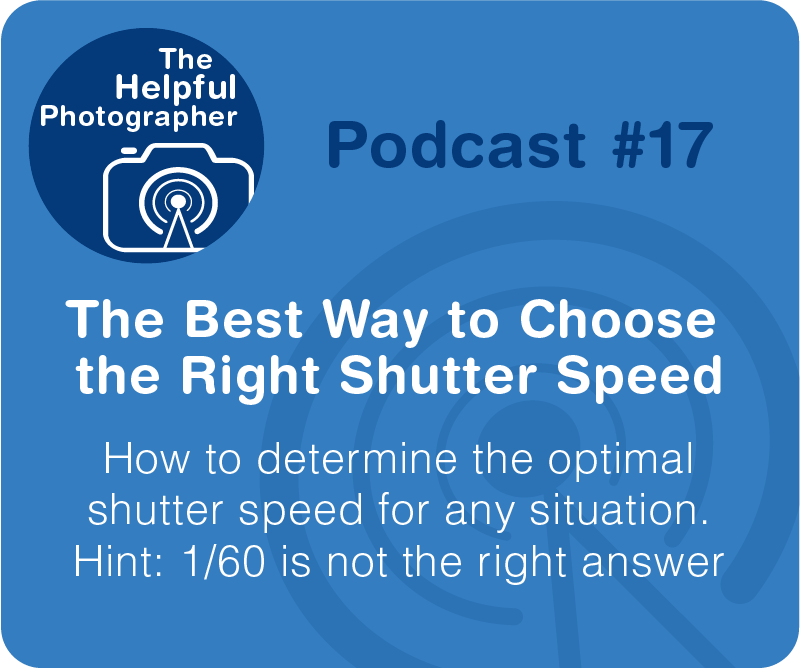The Best Way to Choose the Right Shutter Speed
Photo Tips Podcast: The Best Way to Choose the Right Shutter Speed #17

iTunes
Google
Spotify
Tune In
Stitcher
RSS
Pandora
The Best Way to Choose the Right Shutter Speed #17
When photographers are generally asked what the optimal shutter speed is, most will tell you that 1/60 is the right answer. Unfortunately this is an oversimplification if the problem. Your shutter speed is determined by three factors: subject matter, focal length of your lens and you. The subject: the question is, “is your subject moving or not? We're going to assume that your subject is static in other words, it’s not moving. The second part is your focal length. If you are shooting a full frame camera your base shutter speed, at a minimum, should always be one over your focal length. Let's say you're shooting a 35mm lens, you would take the number one and put it over 35 and find the closest shutter speed to 1/35 , but this is a bit problematic, as I only have the shutter speeds 1/30 and 1/40. My inclination is to err on the faster side so I would choose 1/40. Here’s another example, if your focal length is 200mm you put the number one over 200 and that would be your shutter speed: 1/200 of a second. But what if you are not shooting a full frame camera but are shooting a cropped sensor? In that case you need to account for the crop. In other words you would need to calculate what the equivalent focal length is in full frame. In other words a 35mm lens on a cropped sensor like an APS-C is approximately 50mm full frame, so your shutter speed would be 1/50. Let me say that differently, if you are shooting a 35mm lens on a cropped sensor your minimum shutter speed should be about 1/50, the shutter speed for the same lens on a full frame camera would be 1/40. BTW All of this assumes that you are an average user; as I said earlier the third component in determining shutter speed is you. If you are an average user this will work fine if you are shooting a static object. If you would say you were below-average and you have a little bit of handshake problem you're going to need the shutter speed to be a little bit faster than this calculation. On the other hand if you are an above-average and have very steady hands, it would mean that you can afford to use a slower shutter speed. Given everything I just said, where does the standard recommendation of 1/60th of a second come from? This has been the standard recommendation since I started photography way back in the analog days! The only conclusion I can gather is that back then almost all 35mm cameras came standard with a 50mm lens. And almost all amateur photographers only had the one lens. With an analog camera, the closest shutter speed to 1/50 was either 1/60th or 1/30th of a second. And since we generally err on the faster side 1/60 was the go to shutter speed.
There is one more thing I haven’t mentioned, and that’s technology. If you have a great image stabilization you can actually afford to go as much as a stop or two slower than base calculation I just went over. Since everyone is a little bit different you will have to test your particular system to see what your actual capabilities are. Again this all assumes that you are shooting a non-moving object. So what if you are shooting a moving object and want it to stop the action? In that case you need to take the motion into account as well. At a minimum you need shoot as fast as the action is moving. But the relative distance between the object and the camera will also make a difference as to what shutter speed you will need to stop the action. Although there are lots of basic formulas out there for what shutter speed you should use and when you should use them. They don’t often work because unless you are in the same exact situation for which the formula was created, the formula will usually fail. You might get lucky and they might work for you under certain circumstances, but overall they will not work 100% of the time. Consistent results will only come with lots of practice, trial and error, and experience. Before you go out and just shoot a really fast shutter speed to insure that everything is sharp, you have to keep in mind that there is a price to be paid for that fast shutter speed. The faster your shutter speed the more light you lose. As you lose more light you will need to compensate by adding more light somewhere else like Aperture or ISO. Although, the best thing to do to compensate for this light loss is to add more light. As in actual light; unfortunately very often you can’t do that. So the next best option is by opening your aperture, but once you run out of aperture (and you will do that quickly), you will need to up your ISO, but that will begin to introduce more noise.
So in the end, it’s best to shoot at the slowest shutter speed possible while meeting your visual goals. Whether that is showing motion or stopping action. By keeping this rule of thumb you can be sure to have the best possible aperture and ISO available to you, given your shutter speed constraints.
This rule also applies if you are shooting on a tripod. Generally speaking we don’t really care how slow your shutter speed is if you are mounted on a good sturdy tripod, shooting something that is totally static. The problem is this, the longer your exposure the more likely you are to run into environmental factors such as wind, or perhaps traffic. Yes traffic. If a car comes by it may cause vibration in the ground resulting in a blurry photo. You or someone else may also accidentally bump your camera. So again, shoot as fast as possible while achieving your visual goals.











